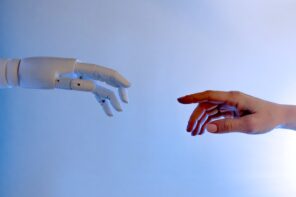“I’m an old, broken down piece of meat.”
—Randy “The Ram” Robinson
A few decades back, The Beatles got into some trouble for a cover of their 1966 album Yesterday and Today. The album cover displayed the Fab Four in butcher’s smocks surrounded by dismembered baby dolls and slabs of meat. The cover was deemed offensive by US industry standards and replaced by a decidedly neutral cover. The controversy was picked up by fiction writer Mark Shipper in his satirical novel, Paperback Writer: The Life and Times of the Beatles, the Spurious Chronicle of Their Rise to Stardom, Their Triumphs and Disasters, Plus the Amazing Story of Their Ultimate Reunion (1977). Shipper twists the story in his recounting, indicating the album was actually entitled Meat the Beatles.*
Shipper’s story stuck, and the rumors have proliferated even thirty years later, so much that I couldn’t help thinking of it while watching The Wrestler. Darren Aronofsky’s fourth feature film portrays Randy “The Ram” Robinson (Mickey Rourke) as a retired wrestler working the meat section at a box store in Jersey. Randy’s movement through the the store’s back corridors are accompanied by Aronofsky’s signature handheld, closed-in camera, as the sounds of The Ram’s entrance into the wrestling arena echo in non-diegetic chorus with Randy’s entry into the deli counter. In The Wrestler, the wrestling ring meets the deli counter: the wrestler as meat meets meat.
You can read, and probably already have, the reviews praising Rourke’s performance; how the film parallels Rourke’s own life as an actor; how his performance should get him close to an Oscar. I leave the heaping of kudos to others. I want to get to the heart of the matter, exploring the religious connotations of meat, and why so many critics left the obvious religious references aside, including reviewers and publications associated with religious groups.
The story goes that The Ram was big in professional wrestling in the 80s, but being an old piece of meat, it is hard to maintain such a vocation for long. The big match from back in the day—immortalized/digitized in a clunky Nintendo game that Randy plays with a trailer-park neighbor kid—pits “The Ram” against “The Ayatollah.” The references themselves, along with homages to the headbanging music of the period, hardly work anymore. But the old political, cultural, and technological quotations begin to underscore the outdated aspects of Randy’s professional life.
Technology has advanced, and video games are much more complicated than shown here, as are political realities. After going into retirement from wrestling in the mid-2000s, the Ram eventually accepts the call to return and fight the Ayatollah once more in a touted rematch. (There may be some political reference in there, given the Bush administration’s ramping up to war with Iran, but that’s another essay.) The glory, downfall, and return of Randy “The Ram” Robinson present the structure for the film’s narrative.
Meanwhile, “Cassidy” (Marissa Tomei) is also portrayed as meat, working at a local strip club easily imagined as a neighbor of Tony Soprano’s “Bada Bing” in Noplace, New Jersey. Cassidy and Randy both use their bodies, and are praised and employed for that reason, and that reason alone. Their meat is ogled and evaluated as it gyrates, bumps, humps, withstands abuse—all while having to meet certain standards of an accepting, usually discriminating public who pays the tab. Like Randy, Cassidy is also a bit past her prime, sometimes having trouble finding clients for lap dances, but still must make money to support her nine-year-old child. (Slyly, A.O. Scott’s New York Times review ends with a note on its “R” rating since, “It has fake bloodshed and real nudity”: This difference is crucial.)
Cassidy and Randy each work double lives, between their bodies as commodities and their bodies that have to pay the rent and support their children. Somewhere in all the meat are identities, struggling for birth. Each carries multiple names: Cassidy is “Pam,” while Randy “The Ram” Robinson is actually “Robin Raminski”—his character’s complexity unveils at least three names, as The Ram, Randy, and Robin. Yet, as with religion itself, and multitudes of other social structures, the crux of the matter of identity is the human body in all its aged protuberances, its scarified flesh, its rotund, risqué, and otherwise resolute features.
That many major US film critics (Ebert, Turan, Hoberman, Scott, et al.) praised Rourke’s performance and ignored the religious dimensions shows how little, again, the news media has any clue about religion, except when something like Mel Gibson’s Passion is stapled to their foreheads. Stranger still, even reviews published in explicitly religious venues—Christianity Today, Hollywood Jesus, Catholic New Service, and Plugged In—scarcely noted the religious symbolism teeming in the film.
Catholic News Service seemed more concerned about the blood and pole dances than anything else, while Focus on the Family’s Plugged In review was also startling in its absolute devotion to the sex, violence, and drugs of the film. Christianity Today’s review makes one wonder why they even reviewed it in the first place, as it seems to indicate the film has nothing to do either with “Christianity,” or “today” for that matter.
More specifically, it’s curious how few religiously-oriented reviewing outlets were able to see possible symbolic references to, say, Abraham and Isaac, Jesus, or others. So, I’m left wondering, did the reviewers blink their eyes, or reach down for another bite of popcorn, at the images of a tattooed Jesus Christ on Randy’s back? Or the “Job” (pronounced with long “o”) inked into the skin of his middle finger? Or the white fleece vest he wears on his entrance into his final fight?
A couple of reviewers did pick up on Cassidy’s heated endorsement to the blissfully ignorant Randy of Mel Gibson’s The Passion of the Christ, exclaiming, “Dude, ya gotta see it! They throw everything at him: whips, chains…” to which a confused Randy replies, “tough dude.” Cassidy sees Jesus as a real wrestler, showing both her investment in the fiction of the violence, but equally her invested belief in Randy as a tough dude. Theirs is a physical Jesus, a body that could take it, á la Gibson’s Christ; unlike Gibson, Aronofsky’s tale is disinvested of tacky teardrops falling from the sky and cheap-trick resurrections.
The reason reviewers passed over the religious is not simply, I suspect, because of religious illiteracy, but because of the received wisdom of late-modern culture that continues to dwell on a body-soul dualism, with the soul in power, the body a mere marionette. Several of the religious review sites described Randy’s body in metaphorical terms: Randy’s heart attack was really a comment on his loneliness, a broken heart over his daughter’s estrangement, and the utter lack of any other community. Reviewers persisted in maintaining this dualism, that the double identities Randy and Cassidy both share ultimately want to get to some core non-physical identity, some materially transcendent spirit, some individuality that is more about the myth of modern individualism than about anything religious. Therein they miss the (religious) point.
And this is where I will go on record to suggest that Darren Aronofsky is one of the greatest living religious filmmakers. I confess, I’ve been a fan since his first feature length film, π (alternatively titled: Pi: Faith in Chaos, 1998) made on a shoestring budget, which brilliantly investigated the myriad dimensions of religious experience, and how body and soul are not separate. Even the film’s accompanying Web site made clear that he understood the ambiguous relations between religious ecstasy (i.e., Kabbalistic mythologies) and chemical imbalances in the mind (i.e., migraines).
Aronofsky is too smart to deal in binaries, and so even back then he was already dissecting this material-spiritual difference with that of artificial intelligence (i.e., computers gaining self-awareness), chaos theory applied to the stock market, and the simple search for love and connection in the world. In the end, Pi’s protagonist Maximillian Cohen (Sean Gullette) drills into the core of it all and finds a revelation. Pi is both literally and quite physically an “apocalyptic” film, and Aronofsky shows how the metaphysical and the physical cannot be bifurcated. Such examinations continue, to greater or lesser effect, in Requiem for a Dream (2000) and The Fountain (2006), interrogating the relations of biochemical influences and transcendental experiences.

And so it is with the finale of The Wrestler. It is Randy/Robin/the Ram’s final leap that sutures the soul and body together in the film. Meat is who he is. This is Hans Holbein’s Dead Christ (above), beyond crucifixion and beyond resurrection (and none awaits).
He is the Ram, not Jesus, not Isaac. There is no angel holding back the lifted blade. The angel waiting in the wings may have been Cassidy/Pam, but she too has left the building. There is no one to live for, so he can only die for the people, for who he is: “an old, broken down piece of meat.”
* * *
*The above article originally stated that the Beatles’ 1964 album Meet the Beatles was originally called Meat the Beatles, and that it, and not Yesterday and Today, was meant to feature the infamous “Butcher Cover.” We deeply regret the error.




